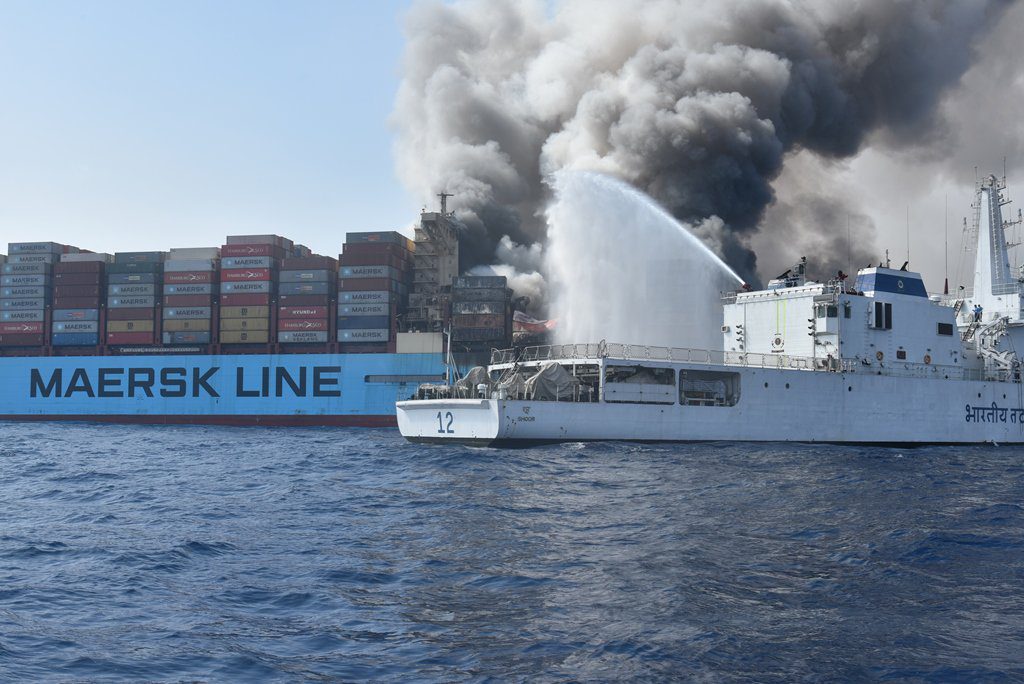The investigation into the fire on board Maersk Honam boxship by the Transport Safety Investigation Bureau (TSIB) of Singapore has shown that it is highly likely that the fire originated from the decomposition of dangerous cargo generating intense heat.
Maersk Honam was hit by a major fire in March 2018 while en route in the Arabian Sea towards Suez, claiming the lives of five of 27 crew members on board.
The vessel suffered extensive structural damage in the accommodation block and forepart of the vessel and was towed to Jebel Ali during the salvage operation. Subsequently, the vessel was rebuilt in Korea before returning to operation in August 2019 under the name Maersk Halifax.
The investigation report indicated that the cause of the fire is not conclusive, however, the most likely source of the fire is to be found amongst a block of 54 containers with IMO Class 9 Dangerous Cargo stowed inside the cargo hold no. 3 in the forepart of the vessel.
“As most of the evidence were destroyed by fire, it is not possible to conclusively determine the cause of the fire,” the report reads.
“However, as chlorine-smell smoke was noticed at the onset of the event, it is possible that one or more containers in no.3 cargo hold containing Sodium Dichloroisocyanurate Dihydrate (SDID) were compromised by selfdecomposition of the SDID. The block stowage of the SDID further exacerbated the rate of reaction and heat production which resulted in an uncontrollable spread of the fire.”
The report further indicates that the IMDG Code does not recognize the potential thermal instability of this material, allowing for SDID to be stowed under-deck where the main fixed firefighting means was CO2, which is ineffective to tackle fires associated with such materials.
“Noting the secondary hazards presented by SDID, which are not captured in the current provisions of the IMDG Code, the provisions in the IMDG Code would need to be reviewed. In the interim, appropriate measures, similar to those adopted for calcium hypochlorite as identified by CINS could be considered for adoption,” the report pointed out.
The fire on the Maersk Honam prompted Maersk to undertake efforts to avoid similar incidents, including the introduction of new guidelines for stowing dangerous goods on the company’s vessels.
Aslak Ross, Head of Marine Standards at A.P. Moller – Maersk, said the company already implemented the main safety recommendations in the report over the past two years and that it plans to further understand and implement the recommendations going forward.
“This was one of the most serious incidents in the history of A.P. Moller – Maersk and we are devastated that five colleagues lost their lives and that five families lost their loved ones,” says Palle Laursen, Chief Technical Officer, A.P. Moller – Maersk.
“The magnitude and intensity of this fire made it impossible for any crew to successfully contain, making it key that we as an industry take steps to address the root cause to ensure seafarers never find themselves in a similar situation. We hope this investigation will initiate a more holistic, industry wide approach where we address the concerns regarding containerised dangerous goods across the entire supply chain – starting at the manufacturing level and following through until the box has been safely delivered at destination to the customer.”
Copyright Ships & Ports Ltd. Permission to use quotations from this article is granted subject to appropriate credit given to www.shipsandports.com.ng as the source.

